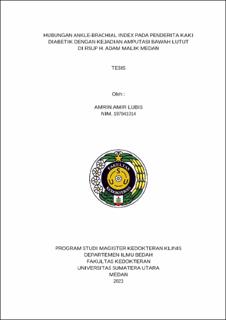| dc.description.abstract | Introduction: Diabetes mellitus (DM) is a metabolic disorder characterized by hyperglycemia resulting from abnormalities in insulin secretion, insulin action, or both. Diabetic foot ulcer (DFU) is a common chronic complication of type 2 DM. Ulcers, infections, gangrene, amputations, and death are serious complications. The American Diabetes Association (ADA) recommends ABI as a test for lower limb vascular evaluation. ABI assessment can determine the level of obstruction in the lower extremity arteries.
Objective: To determine the relationship between Ankle Brachial Index (ABI) values in diabetic foot patients and the occurrence of below-knee amputations at H. Adam Malik Hospital in Medan.
Methods: This study is a descriptive-analytic research with a retrospective approach, conducted from October 2021 to April 2022. The study was conducted on diabetes mellitus patients with diabetic foot symptoms at H. Adam Malik Hospital Medan. The sampling technique used was consecutive sampling. Medical record data, including demographic information, amputation-related data, ABI values, and patient treatment duration, were collected and analyzed using SPSS software.
Results: A total of 34 subjects were included in the study, with the highest age group being 50-60 years old (14 individuals). The subjects comprised 26 males and 8 females. The majority of diabetic foot patients had severe Ankle Brachial Index (ABI) values (44.12%). Out of 34 individuals, 26 underwent amputation surgery, with 23 of them having moderate (0.5-0.79) and severe (<0.5) ABI values. Bivariate analysis using the Spearman test showed a significant relationship and strong correlation between Ankle Brachial Index (ABI) values and amputation incidence (r= -0.633, p = 0.001).
Conclusion: A significant relationship and strong correlation were found between Ankle Brachial Index (ABI) values and amputation incidence (r= -0.633 and p = 0.001). | en_US |


